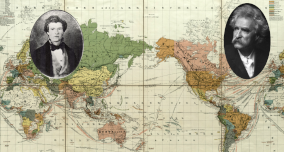Bear Creek passes through southern Hannibal, about a half mile from Sam's boyhood home. He learned to swim in Bear Creek and as with other boys ignored the ordinance against swimming within the city limits. He saw two friends drown there and claimed to have nearly drowned there twice, himself. See chapter 55 of Life on the Mississippi.
Bear Creek—so called, perhaps, because it was always so particularly bare of bears—is hidden out of sight now, under islands and continents of piled lumber, and nobody but an expert can find it. I used to get drowned in it every summer regularly, and be drained out, and inflated and set going again by some chance enemy; but not enough of it is unoccupied now to drown a person in. It was a famous breeder of chills and fever in its day. I remember one summer when everybody in town had this disease at once. Many chimneys were shaken down, and all the houses were so racked that the town had to be rebuilt. The chasm or gorge between Lover's Leap and the hill west of it is supposed by scientists to have been caused by glacial action. This is a mistake.
In The Life of Mark Twain: The Early Years, 1835-1871 page 48, Scharnhorst writes of the meatpacking on Bear Creek:
The leading industry of Hannibal was meatpacking—particularly pork. If Chicago was the “hog butcher of the world,” then Hannibal was the hog butcher of the region—what Carl Sandburg might have called the city of the pig shoulders. Dixon Wecter described the village as a “miniature porkopolis.” The three packing companies in the town, with their pigsties on Bear Creek, a half mile from the Clemens house, employed three hundred workers in season. With a forty-thousand-square-foot slaughterhouse, the firm of Samuel & Moss was among the largest pork and beef packinghouses in the United States. According to Lorio in one of his Hannibal letters to the St. Louis Reveille, the senior partner, William Samuel, “cleared some twenty thousand dollars by dealing in pork” during the fall and winter of 1846-47, The junior partner, Russell Moss, was the father of Mary Moss, one of Sam’s classmates, whom he thought “very sweet and pretty at 16 or 17.” Two new slaughterhouses were built on Bear Creek in 1846, and Dowling & Company, one of the rivals of Samuel & Moss, built a twenty-thousand-square-foot slaughterhouse a year later that enabled the business to ship five hundred barrels of processed meat and lard per day. The packers paid local farmers a premium price, about five cents per pound for porkers that weighed at least 180 pounds, and the Missouri Courier reported in December 1849 that together the “slaughtering houses kill from 1000 to 1500 [hogs] per day” during the late fall and winter.”*
The result was environmental disaster. The farmers herded their droves through the streets of Hannibal en route to slaughter, and not until 1911 were the streets cleaned routinely. The first town council considered the packinghouses a public health hazard and decreed “that no vegetable matter, unclean substance or filthy water be thrown into the streets or into Bear Creek, that refuse from the slaughterhouses be conducted into the Mississippi and out into the current so that it could not return to the shore.” But the ordinance did not prevent tons of offal from draining into the river. Bear Creek became so polluted with dissolved fat it was nicknamed Soap Alley. For obvious reasons, the preachers baptized their converts and boys went swimming in the creek upstream from the packing plants or in the Mississippi above the mouth of the creek.
Not until 1851, with the start of construction on the Hannibal and St. Joseph Railroad along the river, was Bear Creek finally covered through town, becoming an underground sewer. (page 49).
